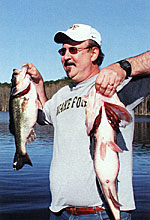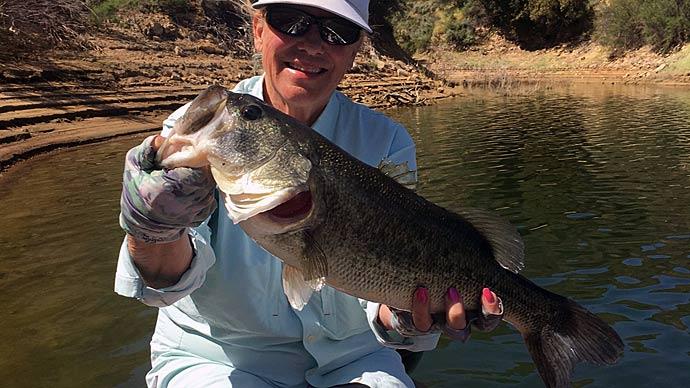
Loyal Pond Boss readers have read the story about Richmond Mill Lake in Laurel Hill, North Carolina. A 125 acre lake, steeped deeply in history, renovated, refreshed and then restocked. What happened next reminds of one of those Ginsu knife sales commercials, "But wait, there's more!"
Perched around a conference table, looking through a giant plate glass window over this cypress-lined grand old lake, Morgan Company President Jim Morgan, Property Manager Dave Buhler, Sweeney Feeder Company President Zach Sweeney and Sweeney Engineer David Atkinson scratched their heads to think how to solve the next logical problem.
How in the world should you effectively feed 7,000 pounds of feed trained bass and 125,000 bluegill in such a large lake?
That was the problem of the day.
The solution seemed simple enough. Feeders, lots of them. The Morgan Company, after shopping the industry a bit and talking with B.A.S.S. founding father Ray Scott, decided to invite Sweeney to company headquarters for a sit down visit and consultation. Sure, they could simply buy feeders, but Morgan and Buhler wanted more than that. They wanted a management system, a feeding program. Buhler, more specifically, wanted to efficiently maintain feeders and come up with a way to keep them full.
But, how?
It seems Sweeney and company has spent several years in Central and South America, working on an automated feeding system for shrimp farmers. They were thinking a similar system might work for Morgan Company's unique challenge.
Atkinson, a techno-guru with his brain fed into anything electronic took the lead. "We can create a system of feeders on the lake, tie them together electronically and monitor them from the office." Sweeney brought the point home.
"The system can be designed with several different types of feeders, used to feed different sizes or species of fish around specific areas of the lake."
The next few months were spent designing and installing a state of the art feeding system for this pristine recreational lake.
Why feed the fish? This area of the United States is renowned for sandy, acidic soils and black, tea-colored acid water. Not real biologically productive for fish. While the lake has a history of producing monster bass, it hasn't produced big numbers of them. With a pH of 5.3 and 7-9,000 gallons of water flowing over the giant concrete spillway every minute, the Morgan Company has been challenged to think "outside the box" in creating a marketable fishery.
With stocking of feed trained bass with an average weight more than two pounds, feeding is deemed necessary. "We knew when we stocked the lake we would need to feed the fish," Morgan said. "We also respect Zach Sweeney and his company. We knew they could help solve the problem."
What's the problem? The guys wanted as foolproof a system as could be designed. Atkinson and Sweeney huddled for several weeks and came up with the following plan.

Twenty-five directional feeders, fifteen scatter feeders and ten vibratory feeders would make up the system. Each feeder would be connected, via a secure firewalled wi-fi system around the lake, to a laptop computer in command central, in the Morgan Company office. Instead of each feeder depending on manually set timers inside each unit, a technician can take the laptop anywhere on the lake and change the settings of any or all feeders. As a matter of fact, with the proper codes, a computer technician can "talk" with any feeder from anywhere there's internet access. Anywhere on the planet.
Feeders were installed and spread evenly around the lake, dispensing feed as needed, based on instructions of the consulting fisheries biologist.
Buhler said, "Watch this"...as he unfolded the laptop on his lap in a lawnchair from the confines of his pontoon workboat in a cove of Richmond Mill Lake. As he pecked away on the keyboard, he smiled and looked up. Feeder number 8, about twenty feet away, was activated. A red light on top of the feeder lit up, the feeder kicked into gear, and spewed several Pounds of floating fish food to the take surface, to be quickly gobbled up by neighborhood bass and bluegill.
It was an amazing sight.
Just think of the applications.
Attach remote cameras to several feeders, and watch your fish eat ... from the comfort of your living room. Heck, you can watch your fish eat from your buddy's living room. All you need is access to the Internet.
Five wi-fi antennae are strategically placed around the lake, each powered by a solar charged battery.
The other problem to be addressed is how to expeditiously fill the feeders. With their heavy duty pontoon workboat, getting feed to the feeders is not a big task. But, who wants to lift bag after bag of fish food and pour into a feeder from a boat, especially on a choppy day?
More ingenuity. Each feeder sits on a stainless steel platform, inches above maximum lake level. Each platform looks professional... expanded metal on top so feed can drop through, camo rim flashing around the edge, adjustable legs. Well thought out.
Sweeney and company has designed a prototype feed delivery system, a pipe with some type of blower that blows feed up the pipe and into the feeder. Just take the top off the feeder, move the pipe into place and turn on the blower. Feed from a bucket or a hopper is blown straight into the feeder. No backaches.
The system is not cheap. With feeders adapted to necessary electronics, an extra large solar battery charger and extra bells and whistles, the cost is more of an investment. Morgan explained his thinking why to buy the system. "First and foremost, we want to efficiently feed the fish. We don't have many employees, and they have a number of daily tasks, so having a smooth running efficient feeding system that doesn't require lots of attention is attractive to our style of management."
There are other motives, too. Marketing is an important factor. Another important angle for Jim Morgan is the secure website and wi-fi system while fishing on the lake. "We are still exploring the best business model how to use the lake for revenue. We know this, businessmen will play a role in what we do. Our corporate clients can fish and take care of business online at the same time. Although it sounds kind of novel, you can set the hook' with your left hand while buying shares of your favorite stock with your right," Morgan said with his tongue only halfway planted in his cheek. "Seriously, while we have a great lake in the making, we plan to specially cater to business clients wanting to escape but be able to stay close to business."
Zach Sweeny has some vision triggered by this and similar projects. He sees not only a shift in traditional methods of feeding and caring for fish with this advanced technology, but a shift in his business paradigm. "For years, we have sold feeders. A customer orders feeders, we ship, and then they order more feeders. Feeders and other products associated with feeders, that's been our business model. The Morgan Company project has us thinking about the value of service related to our feeders. I see us moving more into the service business, along with the tried and true model my father started years ago.
Sweeney sees many more diverse applications with this type system, also. "Imagine the deer business. My gosh, that industry has grown tremendously over the last few years. With a similar system as designed with the Morgan Company, we can see wildlife management ranches around the country monitoring their feeders, and using live feed video cameras to keep an eye on their herds."
There are applications yet to be conceived. Security applications, range management, water quality monitoring.... the creative spark is just now igniting.
In the meantime, there's a lake in North Carolina setting the pace for cutting edge technology while using proven methods to nurture a budding bass lake.
Reprinted with permission from Pond Boss Magazine



